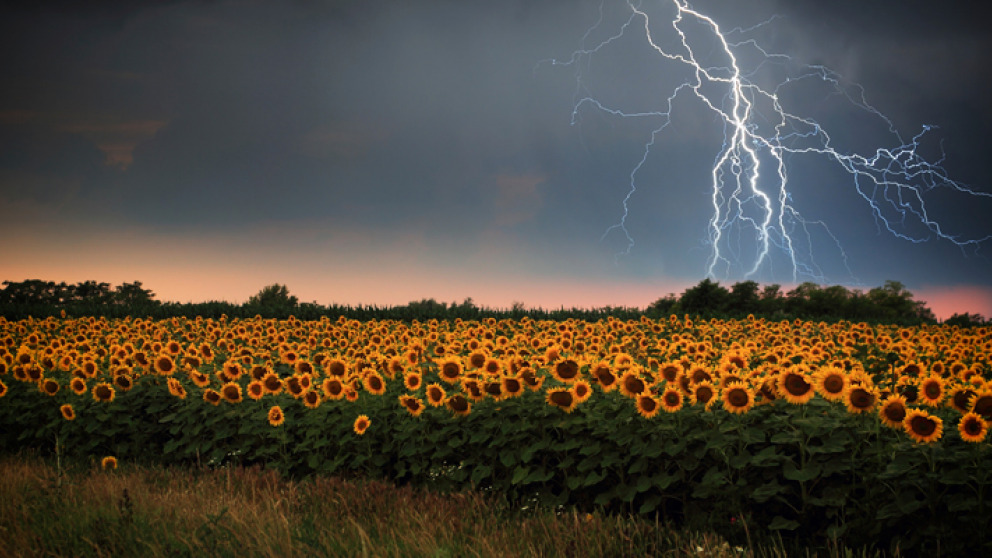Headline:
Climate Change and the Imagination: Q&A with Manjana Milkoreit

The IASS recently hosted a presentation titled Imagination in World Politics - Climate Change, the Mind and the Future by Manjana Milkoreit, a postdoctoral fellow at Arizona State University. In a ‘flash fiction’ exercise after the talk, participants collectively developed very short fictional stories about the future, in which climate change impacts have become a reality and the well-developed societies of Europe are responding to these impacts. Milkoreit is currently leading the multidisciplinary Imagination and Climate Futures Initiative and is involved in projects exploring the conceptual development of the Anthropocene, the science-policy and science-diplomacy interface, pop-culture and climate-related mobilisation, and the nature of ideologies. She has also been recognised for her research exploring the HBO series Game of Thrones as an example of “climate fiction”.
We sat down for a few questions about the role of imagination in climate politics, her research, and whether winter is coming.

The first time I walked into a political science lecture, I was told that politics is about the rational application of power. What does imagination have to do with politics in general, and with climate politics in particular?
All politics starts in the mind, even if it’s a rational choice kind of politics. Whether it’s revolutionary change, the invention of democracy, or designing a new policy like reducing greenhouse gas emissions, you need to conceive of a new reality that is not yet in existence. If you ask a cognitive scientist, that involved processes of imagination! There’s increasing interest in cognition and emotion in the social sciences more generally; researchers are interested in how brains work and how emotions affect people. The specific phenomenon of imagination is a kind of mental process that helps people explore desirable and undesirable futures before they happen. It’s about creating a discussion about what the future might be like and what we want it to be like. If there’s a gap between likelihood and desire, we need a path to bridge that gap or shift our direction with the decisions we make today.
Imagination might be more important in climate change than in other policy arenas, because the choices we make – or don’t make – will bear fruit over a very long time scale. And climate change itself is an abstract idea that requires imagination: you cannot see or touch it! Your brain has to create images, ideas and concepts – mental representations – to make the phenomenon real. All political entities that you cannot experience with your senses – climate change, the nation, democracy – have to be imagined.
Imagination therefore helps us to understand how long-term dynamics on this planet might affect our ways of life. It forces us to think in complex systems terms, training our minds to identify the linkages between environmental and social change. Connecting us with the future, the imagination plays a role in motivating our decisions in the present. It shapes our individual and collective understanding of the choices we have and how they might affect these long-term patterns of change. Imagination creates a mental background condition that gives us a sense of the state and functioning of the world and its direction. Individual decision-makers can use this background information to make policy choices or change their personal behaviours in the pursuit of future-oriented goals.
At the same time, it turns out that humans aren’t very good at imagining the future. We have weak capabilities to imagine things that we have never seen and that have not happened in the past. For example, we don’t know what a 1.5°C temperature change means to human life in 2074, compared to a 3°C change. Imagination is necessary to give us meaningful representations of the future, and the capacity to determine political goals in that context.
And arts and culture have a role to play when it comes to imagining climate futures! Our minds aren’t good at seeing the future in charts numbers, or graphs. But they are good at telling and understanding stories, which has been the dominant form of information sharing and learning across generations and cultures in human history. Story-telling can help people grapple with complex challenges, to simplify and highlight difficult dimensions of human existence to aid decision-making.
How might imagination change how we have traditionally investigated how politics are conducted?
Imagination is not only about investigating individual minds and brain processes – that’s the first step. People and their individual minds are also deeply imbedded in social contexts and networks. And they interact with nature and the human-made environment of buildings, cities, roads, etc. All three factors influence what we are capable of imagining and doing – the “possibility space of existence”. If possible futures are shaped by natural processes, as well as by social, technological, and economic changes over long periods, how do these pieces interact?
Investigating both the individual-cognitive as well as collective-social processes of imagination is challenging. Mental and emotional phenomena are fleeting and not easily accessible to a researcher. We still have to rely on fairly rudimentary observation tools and self-report methods (e.g., interviews and surveys). But given recent advances in the cognitive and neurosciences, I am optimistic that our methodological toolbox will soon expand and provide us with new ways to explore the political imagination.
If humans tend to be bad at thinking about the future, it would seem to indicate that we only address problems that pose a clear and present danger. Do you feel that imagination might foster more creative, long-term, open-ended ways of steering a problem – or our whole civilisation?
I think that’s possible. But one can also challenge the premise that imagination will always make things better. Perhaps people imagine futures that are misconstrued, which could make transitions more difficult. Or perhaps the future is psychologically distracting and slows down productive processes in the present that we need to make change. And imagination is a double-edged sword that can open up or close down thinking. You can create ideas about one kind of future, illuminating one spot in a huge possibility space. But all other possibilities are still in the dark. Now your brain zooms in on that one narrowed reality, and leaves out things that might be important or desirable. So, diversity in the stories we tell might be very important to ensure that we don’t get stuck on one.
Tell us about the Imagination and Climate Futures Initiative that you are heading at Arizona State University.
The initiative was created about a year ago. Our purpose is to explore the role of imagination – or its absence – in the human response to climate change. Is there a link to politics? What are the methods by which we can track its influence? Why might some individuals be better at imagining than others, and how can we foster imagination? What is the role of art and culture in fostering imagination about climate futures, and can we leverage such imagination to create more responsive publics or creative responses to the climate challenge?
The initiative has three tracks. Through a set of public outreach events we want to engage a broader audience in conversations about imagination, story-telling and climate futures. Our lecture series started with Margaret Atwood last year. This fall we look forward to a visit by Paolo Bacigalupi, the author of The Windup Girl and The Water Knife. We are also building a research programme, and we integrate imagination-related themes, for example, climate fiction (cli-fi) into teaching.
Do you plan to investigate climate models and policy documents that might also contain imaginaries or pictures of the future?
Models are the most dominant tools for imagining the future in climate politics and a lot of questions can be asked about their effectiveness. I have started to look at visioning documents produced by corporate or energy actors. Naturally, they describe futures in which the corporations not only exist but thrive, typically in world with significant similarities to today. They simply assume a stable identity over many decades, despite the current signals of impending global economic decarbonisation, e.g., the recent G7 declaration on climate change. It will be interesting to see if and how these documents and identity assumptions change over time.
I am also interested in a related question: to what extent do artists and authors use scientific (model-based) information? Do their fictional worlds have to be scientifically correct?
Let’s talk about Game of Thrones! I read on a blog that in the show’s plotlines, it’s very easy to get lost in the gory, intricate schemes amongst the political elite. Yet the only real, collective, existential threat is bearing down from the north, out of sight and mind.
Winter is coming! That’s the basic link that people make between climate change and the show. I’ve also read a lot of these blogs for my own research, and there are many other parallels bloggers identify between the fictional world of Westeros and our own. The climatic threat in GOT might be cold and ours hot, but it’s also about food and water availability and human welfare based on long-lasting climatic change. Another parallel is the Night’s Watch and real-world climate scientists or environmentalists, who call for preparations and support to little avail. Third, the lack of attention paid to the looming threat is due to preoccupation with more short-sighted, immediate and sometimes petty issues such as power struggles, infighting and debt.
But Game of Thrones is not explicitly “climate fiction”; people who want to raise the issue’s profile have appropriated it.
But that’s the sign of a good work of art: that it is open to interpretation. Environmental and climate activists have made the connection between the themes of the show and their prior thoughts and beliefs about climate change; in a way they are instrumentalising the show and its popular appeal for a political purpose. Their message to the public is: if you feel a certain way about things happening in the show, you should feel similarly about certain things in real life! The GOT metaphor helps people comprehend and emotionally deal with a very difficult topic that is messy, contested, and induces a kind of moral guilt! Piggybacking on a pop cultural phenomenon makes the subject easier to digest and talk about, enabling a dinner-table conversation about climate change. And through the show, political actors might be able to reach far more people than they might ever do with the IPCC reports.
Working at the IASS, an institute that strives to bridge science and society, I wonder: is there a dark side to accessibility? Does it dilute the soberness of the issue or misrepresent it in some way?
Yes, I think that risk exists if you take the metaphor too far. Much of the utility of this form of political communication depends on the stage of your public conversation. In Germany, a GOT-climate change blog might be neither necessary nor impactful. In the US, it makes sense to try to draw people in with a simplified message to get them engaged in the first place. At a more sophisticated stage of deliberation – for example, should we be funding more adaptation than mitigation – blogs might not be useful any more.
Header picture: istock/Balazs Kovacs

Add new comment